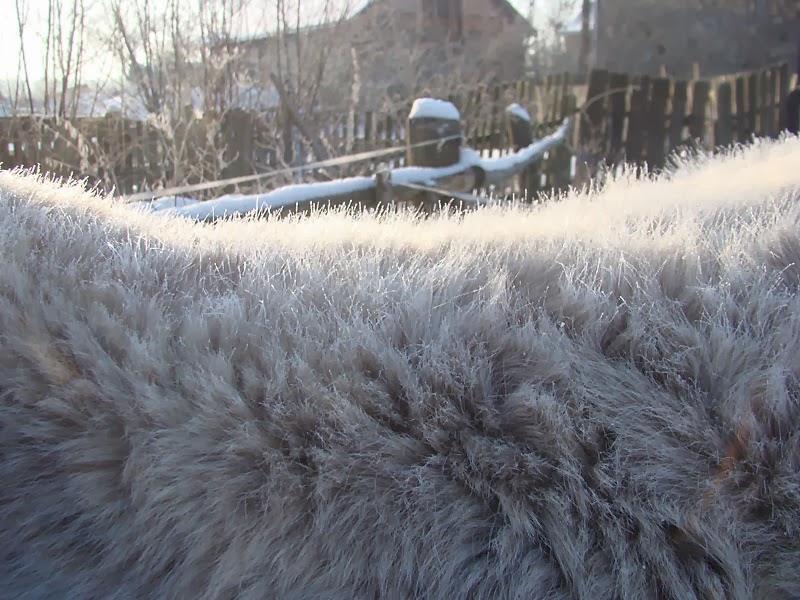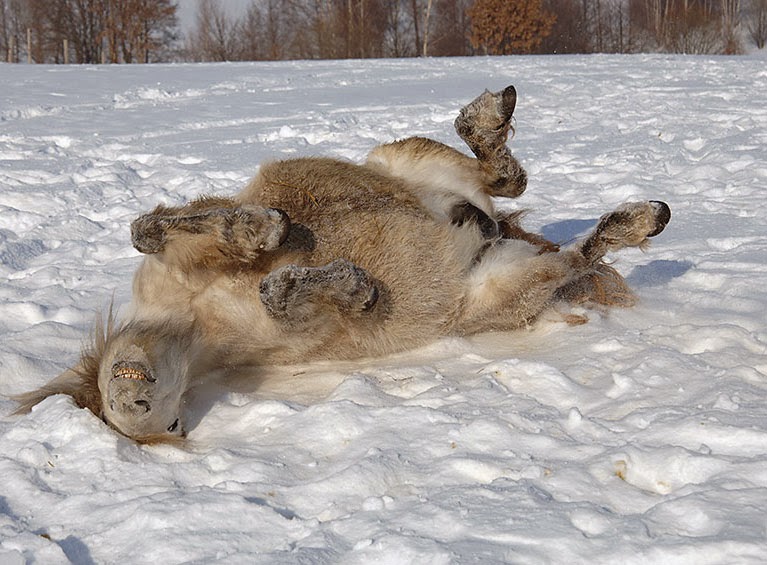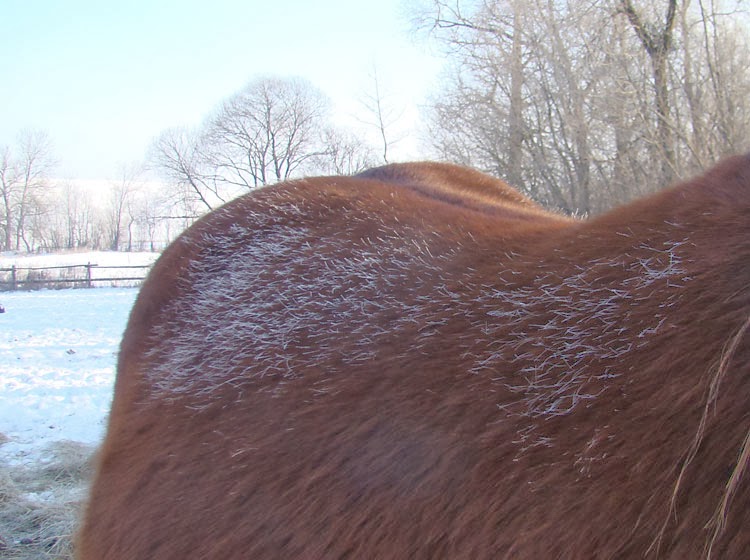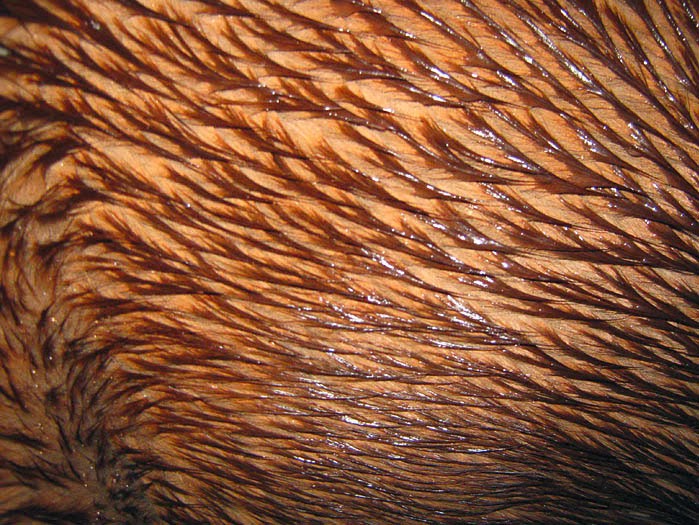Blanketing…science
By: Natalija Aleksandrova
Holistic Horse & Hoof Care
In order for a mammal to survive, internal body temperature is kept within a very narrow range. If the temperature exceeds these limits either above or below, the chemical reactions on the cellular level function improperly. Or they stop functioning at all. Fluctuations outside of the normal temperature range result in health problems or death of the animal. Mature horses maintain their internal body temperature at a range around 38?. Foals, rapidly growing youngsters, pregnant and lactating mares have a higher norm of their internal body temperature (Hines, 2004). Most horse owners are aware of the damage and crisis inherent with fever states. Few horse owners realize how well adapted horses are to deal with cold when certain aspects of their lifestyle are in place for them.
Over thousands of years, the wild horse has spread over the entire world. Whatever place in the world they live, the horse was exposed to constantly changing temperature — through a day/night rhythm or a seasonal rhythm. Yet even today wild and semi-wild horses, as well as domestic ones, provided with species appropriate living conditions, survive perfectly any conditions Nature exposes them to. Whether it is the north of Europe, or Australian deserts, the horse is exposed to all of Nature’s changing elements — wind, sun, rain, snow, fluctuating temperature, etc. Never in nature seeking such excessive enclosed shelters as man-made stables and barns nor caves, never in nature seeking ways of covering themselves with fabric. The horse has naturally evolved ways of thriving.
Heat in the horse’s body is continuously generated as a by-product of metabolism, and a healthy animal has significant internal sources of heat from the metabolic processes (Bicego at al., 2007). To control internal heat loss during the cold time of year, the horse is provided by Nature with complicated and extremely efficient anatomical, physiological and behavioral thermoregulatory mechanisms. In order that the mechanisms are used in the most efficient way, or at all, the horse requires conditions equaling species appropriate lifestyle environments.
On a genetic level, the domestic horse is the same as its wild counterpart: it has the same abilities and needs to survive. Basically, they do not need anything more from the human than only to provide keeping conditions that this species is supposed to have by dictate of Nature: freedom of movement 24 hours a day, free access to appropriate food 24 hours a day, herd life, proper hoof care, shelter which it can enter and leave freely. Under human care that respects the horse’s natural needs, and provides it doesn’t make this animal a subject for anthropomorphism through stabling, changing eating habits, blanketing, clipping, shoeing, etc., the domestic horse is able to properly use its amazing natural thermoregulatory abilities exactly the same way as the wild horse.
Let’s take a deeper look into how the thermoregulatory mechanisms work in the horse, and how it can be interfered with and damaged through unnatural care and keeping practices.

Coat in an Arabian breed horse on a very cold winter day (around –27?C/–17?F, Central Europe.The piloerection mechanism in use — the hair is raised to increase coat insulation.

Cooling down after playing. Icelandic breed horse, Central Europe.
Photo © K. Jarczewski
First what is important to remember, is that due to some thermoregulatory factors such as the skin and coat being very good insulators, which prevent heat loss, and the muscles producing heat through their movements, it is far easier for horses to warm up in cold weather than to cool down in hot weather, or to cool down after intensive exercising. Cooling down is more difficult for the horse. Horses are adapted to handle cold.The horse’s skin is responsible both for protecting the interior of the body from outside temperature changes. As well as for not allowing heat loss in cold weather. Also it needs to be mentioned that the skin is responsible for dissipation of internal heat generated by muscle action to prevent the body from over-heating. The skins’ thermoregulatory mechanisms consist of four major factors, skin, coat, arteries and sweat glands, three of which are responsible for keeping the horse warm in a cold weather:1. The skin itself works as an insulating layer through its relative thickness.2. The coat.The coat insulation depends on the depth and thickness of the hair layer, the wind speed and the temperature and humidity gradients within the coat (Ousey et al., 1992).The coat, in horses, changes twice a year through the mechanism called photoperiodism, adapting to different seasonal base temperatures. Sensors in the horse’s skin react to the daytime light length changes. The horse is ready to grow their winter coat right after the summer solstice, when days start getting shorter. The horse is ready to change their winter coat to a summer one right after the winter solstice, when days start getting longer.In addition to photoperiod, environmental temperature also affects hair growth. Colder climates produce thicker and longer coats in horses than warmer climates do, when comparing horses who have the same body score and are fed the same amount of food.Also coat growth is affected by some other factors, for example, feeding and horse breed which will be explained later in this text.Additionally to growing its coat, the horse can increase the insulation of the coat through the mechanism called piloerection — raising, lowering or turning in different directions the hair in the coat via hair erector muscles. This way the horse increases or decreases the thickness of the insulation layer and efficiently varies the amount of airflow to the skin surface. Piloerection increases coat depth 10% to 30% in mature horses (Young & Coote, 1973). The hair erector muscles must be exercised regularly in order to work properly, as with any other muscle in the body.Hairs of the coat are covered with a greasy substance, which helps the horse not to get wet to the skin on rainy or snowy days. The coat has a water-repelling effect through the hair grease — water runs down the outer hair while the deeper coat remains dry. The longer the coat, the less chance water has to get to the skin. Through regular coat brushing the greasy substance gets removed, and the water-repelling effect gets impaired.Not advisable either is to clean off the layer of dirt that rolling in mud ensures a horse. The mud has protective effects to the body.Needless to say that the popular practice of clipping the hair of a horse’s coat eliminates, completely, the thermoregulatory factor of the coat.3. Arteries in the skin.Arteries through muscle actions, called vasoconstriction or vasodilation, can be narrowed or enlarged, regulating blood flow to the skin. Constricting prevents internal heat loss by reducing the amount of warm blood brought to the cooler body surface. Dilation allows for a larger amount of hot blood from over-heated interiors to reach the body surface and to be cooled. The cooled blood lowers internal body temperature when it’s returned back to the interior of the body.4. Sweat glands.The horse uses sweat glands to cool down at a time when external or internal temperatures are too hot. When the outside temperature is too high for the air to cool the blood through the skin, the sweat glands secrete fluid. Evaporation of this fluid cools the skin surface and the blood in the surface arteries. In this way, bringing the cooled blood to the internal body, the temperature internally can be lowered even when it is hot outside. The horse stops secreting sweat as soon as the internal body temperature has reached it’s norm. Then it must dry quickly, since otherwise cooling would continue and bring body temperature below normal limits. A sweaty horse turns its coat hairs in various directions in order to avoid under-cooling and given freedom usually seeks a windy spot to effectively fast and safely dry itself. Mentioning the sweat glands mechanism is important because sweat glands are also brought into function through muscle action.
While those are the skins’ four major factors of thermoregulation mechanisms let’s now look into other thermoregulatory mechanisms available to the horse.

Frost on the coat — heat escaped the body.

Water running down the long winter hair, the undercoat staying dry.
The amount of fat in the body is also an important factor of thermoregulation. Since, in addition to being the body’s energy reserve, fat is three times more insulating than other tissues due to its low thermal conductivity and poor blood supply (Guyton, 1991; Davenport, 1992). Thus it is important for a horse to have a good layer of fat before winter. Wild horses and naturally kept domestic horses maintain the natural rhythm of weight change throughout the year with their weight growing up to 20% by the Autumn. Usually we can see that domestic horses with a thicker fat layer in their bodies grow a comparatively shorter winter coat than horses with less fat gain at Autumn, comparing the same breed and the same body score animals. Also fat gets distributed more evenly over the body surface in cold conditions instead of being concentrated in some particular areas as in hot conditions.
Kept in the same conditions, smaller horse breeds have a longer/thicker coat compared to larger breeds. Also we see a typically thicker coat in foals. This is connected to a great effect of allometry, the systematic change in body proportions with increasing body size, on heat balance within animal species. Changes within species occur as animals grow and develop but exist also between breeds of species (Reiss, 1991; Langlois, 1994). Generally, large body size is an advantage with respect to thermoregulation in the cold. Since, the ratio of heat-dissipating surface area to heat-producing/retaining body mass decreases with increasing body size (Phillips & Heath, 1995; Bligh, 1998). Therefore, large size horses have less relative surface area available for heat exchange, and thus importantly lose less heat in the cold than small size horses do. Small horses lose more body heat than large horses do. In addition to large body size, a spherical body shape reduces the surface area to body mass ratio (Langlois, 1994). To compensate for the bigger surface/mass ratio northern-type horses generally have evolved heavier rounder bodies with shorter limbs and extremities which are well protected by thick hair, mane and fetlock, therefore being more able to retain more body heat and cope with cold.
Increasing feed intake increases heat production in the horse’s body. This is connected to the fact that the process of digesting long fibers produces heat as a by-product. It is important that every domestic horse has unrestricted access to hay 24 hours a day. In cold weather having a chance of increasing heat production through continuously consuming and digesting long fiber. Especially when some of the other thermoregulatory mechanisms aren’t yet adjusted in suddenly changing weather conditions such as a rapid drop of temperature.
Such extra demand for feed is called climatic energy demand (MacCormak & Bruce, 1991). Horses have been observed to need about 0.2 to 2.5% more energy for maintenance per 1 degree Celsius drop in outside temperature below their lower critical temperature (Young Coote, 1973; McBride et al., 1985; Cymbaluk et al., 1989a; Cymbaluk, 1990). (Lower critical temperature is individual for every horse/group of horses at different times of year and depends on many other thermoregulatory and environmental factors.)
Importantly, smaller-sized horses have greater lower critical temperature values meaning their heat loss is relatively greater than for larger horses. Thus small-sized horses actually need proportionally more additional feed. To explain further, the greater that the lower critical temperature value is — the more heat loss the animal experiences. Small-sized horse breeds lose more heat than big-sized horse breeds in the same temperature conditions. The lower that the lower critical temperature value is, the greater the heat retention is that the animal experiences. Bigger-sized horse breeds stay warmer in cold weather.
Feral horses have been reported to reduce locomotor activity in winter compared to summer (Duncan, 1980; Berger et al., 1999; Arnold et al., 2006). Reduced activity in winter was an annual pattern related to decreased outside temperature and hence to a reduction in internal heat production and energy expenditure (Arnold et al., 2006). This adaptation mechanism of reducing activity helps wild horses to cope with the energetic challenge of winter. We can observe similar reduction of activity in winter in domestic horses kept naturally. Though the domestic horses aren’t challenged with a necessity to search for food in winter to the same extent as their wild counterparts. This slowing down in their activity obviously has the same purpose as in the wild horses — the reduction of energy expenditure in the cold. Thus, it is a normal seasonal rhythm in the horse to be less exercised in winter due to this cold adaptational thermoregulation mechanism, therefore it is not advisable to forcefully exercise horses in winter.
Along with general reduction of activity in the cold, we have observed in horses, short sessions of restlessness and locomotor activity (movement) during sudden acute cold periods and adverse weather. Short term beneficial movement that is a useful bridge until other factors of their thermoregulatory system adjust to the new temperature conditions.
Sometimes we can observe horses standing or lying down very close to each other, this way they reduce heat loss via radiation. By such positional closeness to each other they reduce the body surface area exposed to the external environment (Bligh, 1998). At the same time animals, who for some reason, don’t produce enough individual internal heat can use, as an extra source of beneficial heat, a paddock mate’s body-heat radiation via positional closeness.
Also by changing body posture and orientation, horses can increase absorbed solar radiation to use as another additional source of heat. Often we can observe that horses prefer to sunbath under the direct sun instead of eating on short sunny winter days, and as soon as the sun sets they are back to eating.
Snow which we can sometimes see lying along horses backs during winter also plays the helpful role of providing an extra protective layer against internal heat loss.
On windy, rainy days, we can see horses standing with their tails to the wind and their heads low. This way they effectively keep their necks, heads, ears and eyes, underbelly and sheaths out of water and wind. Their tails serve to protect their rear ends — the shorter hairs on the dock fan out deflecting both snow and wind. Also on such days, horses can be seen standing in the lee shelter of walls, or using natural windbreaks such as trees or hills to protect themselves from the wind.
When allowed free choice, it’s been observed that horses utilize enclosed spaces, such as shelters or forests, mostly to hide from summer heat and flies.
Under extreme circumstances, heat in the horse body can be generated by shivering. During shivering, heat is rapidly produced by breaking down ATP in the muscles (Langlois, 1994). Shivering is usually an acute response to sudden cold exposure, or sometimes it occurs during extended periods of exposure to cold in rainy weather. In healthy animals, shivering is replaced by normal internal heat production as they adapt to new weather conditions.
A different problem occurs with enclosed spaces when placing a hot sweaty horse into a stable. Due to a lack of air circulating in there, cooling already takes longer and a horse sweats for longer. The air surrounding the horse becomes saturated and drying also takes longer than normal, because the humid air cannot absorb any more moisture. As a result, the horse remains undercooled, again setting the stage for internal disorder: colic, diseases and infections by negatively affecting metabolism’s safe temperature margins.
Blanketing moreover can set the thermoregulation in a horse to a complete mess. The animal tries to warm up parts of the body left exposed to the cold such as head, neck, belly and legs, in the process they become over-heated in those parts covered by the blanket. A horse cannot increase heat in selected area’s of the body. The whole body cools or the whole body heats up. Sweating under a blanket is more of a problem metabolically to the horse than people realise.
Kept in stables or/and blanketed, horses lack stimuli (temperature fluctuations) triggering the activity of thermoregulatory mechanisms. They don’t need to exercise hair erector muscles, nor to dilate or constrict arteries, nor to activate the sweat glands, nor to prepare or deplete healthy fat reserves. All muscles atrophy without exercising for a period of time. If an animal in this state is suddenly exposed to the cold, they will not be able to activate necessary thermoregulatory mechanisms. As a result the internal body temperature could drop too low, that would lead to disruptions in metabolic processes. This can affect, for example, the production and migration rate of white blood cells and antibodies, with partial disabling of them. The result is a stressed animal with a disease or infection hosting internal environment. The germ is nothing, the terrain is all (Louis Pasteur). Consequentially germs or viruses in the body get a perfect opportunity to over breed.
Besides the fact that the natural thermoregulatory mechanisms can only be fully utilized when a horse is kept in their species-appropriate living conditions, there is an anxiety and stress factor that horses inevitably experience when cut off from their basic needs and kept in ways unnatural for this species (stabling, separating from equine companions, forced exercising, lack of continuous fiber uptake, etc.). This stress also makes them less capable of coping with cold.
To review all resources and references for this article click this link to it’s original source and scroll down:
Now… one last thing Natalija did not mention. If your horse has been clipped thus eliminating his ability to use his natural built-in devices and grow his winter coat, or if your horse has been blanketed since Fall so his natural devices have not developed, his winter coat has not grown, either start slowly and with good judgement or wait until next year, depending upon where you are and what your climate is. Then next year no clipping, no blankets, and let him develop his winter devices naturally.


